| 1 | Common in eastern Brazil |
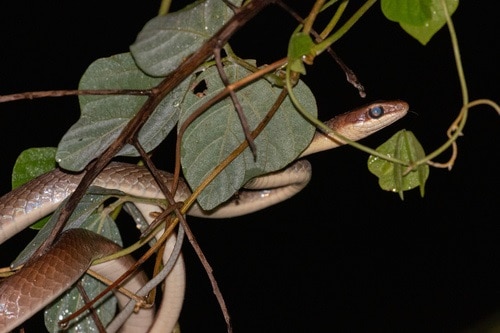
Brazil is full of snakes that could paralyse your lungs and cause spontaneous bleeding from your gums. But most are harmless and coexist peacefully with humans, and a common such character in eastern Brazil is Boettger’s sipo (Chironius flavoineatus), which averages at 80-120cm.
This is a South American species only, coming nowhere close to the Central American border (Panama), or even Venezuela and Colombia. This is an uber-flexible snake. Except the thickest rainforests, high mountains and true deserts, few places are off their sightseeing list. Chironius flavolineatus prefers open ground, but can inhabit dry forests, riverside forests, urban areas, and rocky hillsides. While incapable of killing, Boettger’s sipos don’t hesitate to snap and bite if gripped, and they also release a foul snake smell that engulfs anyone nearby.
Chironius flavolineatus is neither fully ground-dwelling or tree-dwelling (arboreal). They tend to forage on the ground, with their entire diet consisting of frogs, before retreating to a comfy branch perch at night, typically 2 metres above ground. They have several arboreal adaptions, like a long, thin tail, and a slender body to reduce weight. This snake is part of the 23 member Chironius sipo family, also including the machete savane.
| 2 | A manically active snake |
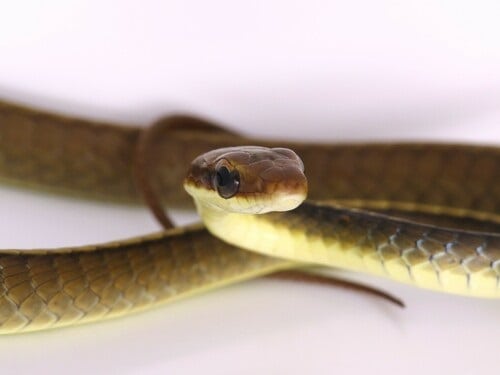
Boettger’s sipo is an active forager, not a lazy ambusher. Each day, they must prowl eastern Brazil searching for new meals, new calories to digest, in a neverending cycle. Each Boettger’s sipo will have many failed lunges, many frogs that slip away, and many unexpectedly weak disguises over its lifetime, yet they simply keep going and going, surviving through sheer determination. Again, they have adaptions for this foraging lifestyle: a fast, whippy speed, and large eyes for improved eyesight.
Boettger’s sipo is exclusively diurnal, never hunting at night. A study from Brazil’s northern Bahia region found that all observations were made from 06:43 to 17:20.
Boettger’s sipos are inventive and exploit their environment in whatever way they can. One sipo leapt from a leaf litter bed onto a low tree branch when scientists approached, escaping their clutches. The same 2016 survey showed how flexible they are. It recorded 21 Boettger’s sipos, in the following places: soil (9 times), bushes (5), leaf litter (3), a fallen tree trunk (1), herbaceous vegetation (1) and a pond (1). This species even appears in caves 30 metres deep, specifically one called Cave of the Rabbits in Ibitipoca State Park. This species is extremely unlikely to go extinct, ever.
| 3 | Swallows frogs while they sleep |
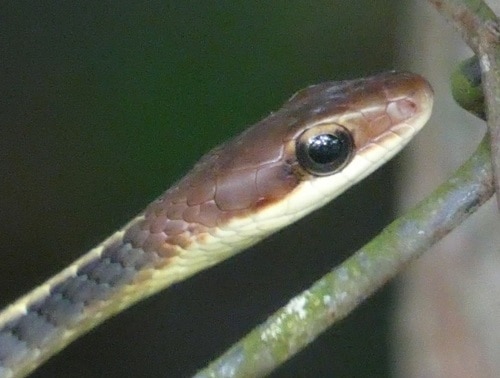
Boettger’s sipo has a highly specialised diet: an exclusive amphibian-eater. The cerrado areas of eastern Brazil are swarming with lizards, yet Boettger’s sipo ignores them and goes straight for the slimy delights of frogs. This isn’t uniform across the Chironius sipo family. For example, the machete savane occasionally eats rodents, and lizards like rainbow ameivas are plentiful in their diet, as well as frogs.
The best study came in 2008. It analysed 167 Boettger’s sipos from university collections in Brazil, along with their close relative the central sipo (171). 17 prey were discovered in the Boetger’s sipos’ bellies, with nearly 90% containing no meals, which is unusually low, showing that this is a snake which regularly goes hungry. Every single prey in Chironius flavolineatus was a frog or toad. 71.1% were Hylid treefrogs, including species like white-spotted tree frogs and Bischoff’s tree frog.
One weird quirk was that the frog prey were mostly nocturnal, whereas Boettger’s sipo is diurnal. There was only one explanation: that this snake is a savage den raider which ambushes frogs while they sleep.
| 4 | Avoids massive meals |
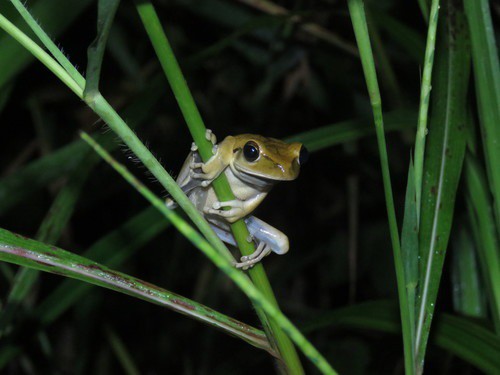
Chironius flavolineatus wisely skips gut-busting meals and focusses on much smaller prey. In the same study, their meals averaged at just 5% of their own body weight, with a range of 0.00-0.21%. Meanwhile, the Paraguay green racer they coexist with in eastern Brazil sometimes dies from its meals, once eating a Peter’s lava lizard 41.4% of its own body weight.
Being thin-bodied, Boettger’s sipo instinctively avoids larger meals, like a black mamba. The single heaviest prey they ate was a Chaco tree frog (Boana raniceps), weighing 17.44 grams. This pale frog is extremely common across South America, and they have competition, as this is a confirmed meal for 3 other snakes: Lichtenstein’s green racer, yellow-bellied liophis, and green parrot snake. The smallest prey was a miniscule juvenile of the frog Thoropa miliaris, weighing just 0.31 grams.
Most prey (65%) were swallowed headfirst, and the central sipo (Chironius quadricarinatus) also ate amphibians exclusively. Several of the tree frogs they ate only create their nests above ground, whether in bushes or on tree branches, hinting that Boettger’s sipo climbs several metres up in its relentless pursuit of food.
| 5 | Dives into streams to escape |
Boettger’s sipo isn’t an aquatic snake in the slightest, preferring open ground and trees. They only have two uses for streams and ponds: as a base for their frog prey, and as a refuge to escape hungry predators.
In December 2018, scientists were exploring the Chapada do Araripe plateau in northeast Brazil, when they found a Boettger’s sipo in a stream, which had a thick bed of leaf litter. The snake noticed them, and submerged to the bottom, burying itself in this leaf litter, where it hid for 6 full minutes, managing to hold its breath. It thought it was hidden, though the scientists filmed its every move with a digital camera.
The Boettger’s sipo then reappeared, but submerged into the stream and leaf litter again, apparently noticing the scientists. This time, it remained under for 1 minute 20 seconds. Eventually, it swam away and emerged from the stream at a further point, trying to escape using dry leaf litter. Boetterger’s sipos can not only hold their breath for ages, but are smart enough to know when a stream or thick leaf bed offers a shelter.
| 6 | ID: search for the creamy stripe |
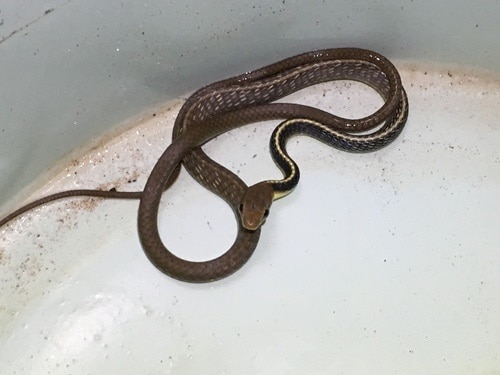
Boettger’s sipo is easy to distinguish from most Chironius sipo members, thanks to a thin, creamy stripe that extends down the entire length of its spine. This has created the alternative name of yellow-striped sipo, and the stripe is bordered by a thinner black stripe on either side. Another ID sign is a brown or beige head, that contrasts sharply with a dark grey upper third of the body.
Boettger’s sipo has little ontogenetic colour variation, keeping the same shades from birth to adulthood. Females are slightly longer than males, though not by much. With 57 Boettger’s sipos tested, females averaged at 115.8cm long. With 37 sipos tested, males averaged at 110.0cm. Females were much heavier though, at an average of 81.15 grams versus 65.0 grams. They also have a thicker body in order to carry more eggs.
Males had the visual advantage, with relatively wider eyes. These were believed to be for tracking down females, scanning the forest for any possible hints of their presence. The study also found that for both genders, the tail was massive, representing nearly 40% of body length.
| 7 | Relatively civilised and cultured |
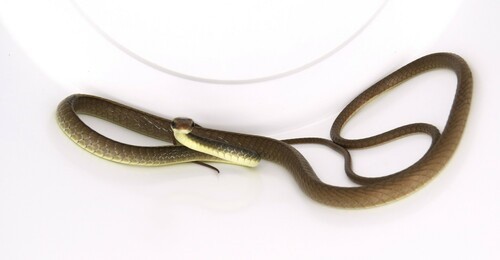
Unlike their close relative the machete savane, Boettger’s sipo males rarely wrestle each other to win female affections, in grand duels lasting for 2 hours while females watch on with popcorn. Apparently, their strategy is more basic. Scientists wandering a riverside gallery forest of Minas Gerais state, Brazil, found one female Boettger’s sipo with six males, all attempting to woo her.
When one male drew close and rubbed his body against her, the next annoyed male simply grabbed its rival and ripped its body away. Then it slithered in for the prize, before the outraged original male reappeared and pulled its rival away again. Then a new male would join the fray and rip both males away. Meanwhile, the female was just getting flustered and stressed out. Apparently, the males were so focussed on each other that they hadn’t noticed that the female snake didn’t care anymore.
This cycle continued for 30 minutes, in which the male sipos sometimes coiled around the female, or rubbed their chin on her body lovingly. Despite their rivalry, the male snakes showed no aggression to each other, no biting for example.
| 8 | Split into three species |
Boetger’s sipo still has a vast empire in Brazil, but parts of it have been chipped away in recent years. In 2014, a new species called Chironius diamantina was discovered in the Chapada Diamantina highlands of Brazil’s Bahia state, which had previously been misidentified as Boettger’s sipo. This had a creamy spinal stripe too, proving it to be a close relative. It lived in caatinga environments around 1000 metres above sea level, and was thought to have no coexistence with Boettger’s sipo lower down.
2015 saw a bigger change, when another new species was discovered: Chironius brazili. It turned that many members of this species had been confused with Boettger’s sipo for decades. C. brazili occasionally overlapped with Boettger’s sipo, inhabiting cerrado and riverside forests at elevations from 0-1360 metres, usually above 590 metres. The main physical difference was that Boettger’s sipo had a consistently cream-coloured belly. With the new Chironius brazili, the belly (ventral scales) gradually darkened instead. Genetics proved them to be separate, and it’s thought that they diverged 5 million years ago.
C. brazili reaches further south than its cousin, even reaching Uruguay. But it’s far less common overall, mainly inhabiting southeastern Brazil. A 2017 study added some new details, revealing that C. brazili tended to inhabit cooler areas than Boettger’s sipo, favouring highlands that occasionally dropped below Oc.
| 9 | May contain 2 more species |
We probably aren’t done with the new species yet either. The entire Chironius family is believed to have been originated 20.2 million years ago, while Boettger’s sipos diverged from the rest 5.05 million years ago. But in 2017, scientists analysed Boettger’s sipos from all over eastern Brazil, and found massive genetic chasms between certain populations.
Clade 1 came from the coastal lowlands of Rio Grande do Norte and Paraiba, and was believed to be the real Boettger’s sipo. Clade 2 came from the Serra da Ibiapaba highlands, found in northeast Brazil, which are 600-1100 metres above sea level, and contained remnant Atlantic forests with a high amount of rare species. Clade 3 consisted of a snake found in northeast Brazil, in the Serra das Três Barras highlands, at over 800 metres.
The latter two were both theorised to be undiscovered independent species, hiding within the Boettger’s sipo umbrella. For example, clade 2 and clade 1 were estimated to have diverged 0.56 million years ago. There was evidence of deep genetic separation between the 3 groups. In a few years, yet more snakes could be added to the 3900 we know about worldwide, and the 23 Chironius (sipo) family members.
| 10 | More unsolved mysteries |
New locations for Boettger’s sipos are still being discovered. In 2015, they were confirmed in French Guiana for the first time. One was found in the centre of the Kaw river in 2013, floating on a piece of vegetation, and instantly identified by its creamy spine stripe. The scientists had spotted a fast snake zooming around Kaw village for years, suspecting it was a Boettger’s sipo, but never getting close enough to make an ID.
Finally, in February 2015, they captured a snake measuring 93.5cm which was proven to be Boettger’s sipo. These observations extended its territory a whole 700 kilometres to the north.
But they’ve also disappeared from Peru, which used to be on their territory maps. Not because they’ve disappeared, but because scientists examined the individual found in Peru, still in storage, and found it to be the wrong species. There was no signature creamy stripe, for one thing. Chironius flavolineatus is confirmed in Bolivia, and may just cross into Peru, but it isn’t official yet.
